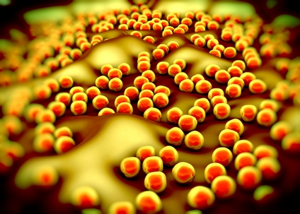Commensal skin bacteria produces anti-cancer agent
The skin is the largest organ of the human body with a primary function of providing a physical barrier to potentially harmful pathogens and toxic substances. Since the skin acts as an interface with the environment, it is, consequently, colonized with a diverse community of microbes. The types of microbes present are determined by the ecology of the skin, and the interaction between these microbes and the skin can influence epidermal function.
The mechanisms by which skin microbes can influence host function are not well understood, but previous research has demonstrated that the skin microbiome is important in promoting host defense. The most prevalent species of bacteria that colonize healthy skin are within the Staphylococcus genus. Specifically, Staphylococcus epidermidis has been shown to release agents that selectively kill pathogenic bacteria, enhance skin immune function, and prevent skin colonization by pathogenic bacteria.
 Commensal S. epidermidis produces anti-bacterial molecule
Commensal S. epidermidis produces anti-bacterial molecule
To further understand the role of commensal bacteria in influencing host defense, researchers at the University of California, San Diego (UCSD) isolated strains of S. epidermidis from healthy human skin and screened for antimicrobial activity. The study conducted by the lab of Dr. Richard Gallo at UCSD was recently published in Science Advances.
During screening, the researchers identified one strain of S. epidermidis that had bactericidal activity against group A streptococcus (GAS), the bacteria that causes strep throat and scarlet fever. The bactericidal activity was attributed to the molecule 6-N-hydroxyaminopurine (6-HAP), which has a similar structure to the nucleobase adenine. Consequently, the researchers tested the effects of 6-HAP on DNA synthesis and found the molecule prevented DNA extension through inhibition of adenosine-thymidine base pairing. Interestingly, these effects were limited to tumor cell lines and did not affect normal human epidermal keratinocytes, indicating selective anti-growth properties that were partially attributed to the inability of the tumor cell lines to metabolize 6-HAP.
6-HAP suppresses tumor growth
The researchers then assessed the anti-tumor properties of 6-HAP in systemic and localized mouse tumor models. Mice were inoculated with a highly aggressive melanoma cell line and then intravenously dosed with 6-HAP or vehicle. Treatment with 6-HAP suppressed tumor growth by more than 60%. S. epidermidis anti-tumor abilities were then assessed using a UV carcinogenesis model. Nude mice were treated with a carcinogen and then subjected to repeated UV exposure, after which they were colonized with a strain of S. epidermidis producing 6-HAP or a control strain of S. epidermidis that did not produce 6-HAP. Mice treated with the 6-HAP-producing strain experienced a significant reduction in tumor number and tumor incidence compared to the control.
Taken together, these findings suggest commensal bacteria of the skin microbiome can prevent tumor formation, and the identification of the selective anti-tumor molecule, 6-HAP, could lead to new preventative treatments for skin cancer.
If you research skin cancer or the microbiome, check out our catalog of unique melanoma and bacteriology reagents provided to us by our many academic partner institutions.


